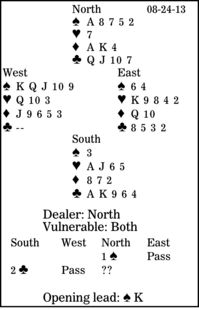Bridge column, August 24: The one card cuts the losers

How wonderful it is when a single card improves the fit and results in a low-point-count slam.
Look at the North hand in today's diagram. You open one spade and partner responds two clubs. What would you rebid?
After a two-over-one response in Standard American, a new-suit rebid by opener is forcing for one round. So a jump rebid can be used as a splinter bid, showing good support for partner's suit, extra values and a singleton (or void) in the named suit. (I think that this is much more useful than describing a good 5-5 two-suiter.)
Here, South, now knowing that his three heart losers can be ruffed on the board, should control-bid (cue-bid) four hearts to suggest a slam. Then North can use some form of Blackwood. At that point, the problem will be to avoid seven clubs.
Against six clubs, West leads the spade king. How should South plan the play?
The deal is perfect for a crossruff. But before commencing one of those, declarer should cash all of his side-suit winners. So, after taking the first trick with dummy's spade ace, South should play a heart to his ace and cash dummy's diamond winners. Then he crossruffs to take one spade, one heart, two diamonds, four spade ruffs in his hand, three heart ruffs on the board, and one top trump. Each defender wins trick 13: West with the diamond jack and East with the club eight.
** ** **
COPYRIGHT: 2013, UNITED FEATURE SYNDICATE
DISTRIBUTED BY UNIVERSAL UCLICK FOR UFS

